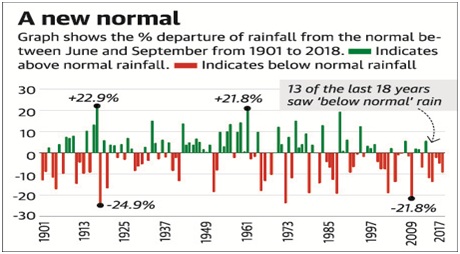
The New Normal
Why in news
- The India Meteorological Department (IMD) is likely to revise downward by 2% the quantity of ‘normal’ monsoonal rain.
- Were this change to happen, the definition of ‘normal’ rainfall could dip below 88 cm, unprecedented since 1950.
- About LPA
- This is the average rainfall that the country got from 1960-2010.
- Normal - 89 cm of monsoon rain from June to September.
- Below normal rains - rainfall less than 95% of the normal.

Why the Need for downward Revision
- The IMD routinely updates ‘normal’ rain every 10-12 years.
- These changes can take nearly 5 years to reflect in the IMD official forecasts.
- This time the change could be reflected by 2021 after taking into account the monsoon rainfall from 1970-2020.
- There is also dip in average rainfall largely due to surge in drought and depressed rainfall since 2000.
Status of Monsoon in India
- 13 out of the last 18 years have seen ‘below normal’ rains.
- 2002, 2004, 2009, 2014, 2015, 2016 and 2017 have been years of drought.
- Research into monsoon
- Experts have suggested rise and fall in average rainfall over 30 to 40 yrs. cycle since 1900.
- Since the 1990s, India is in a ‘low epoch’ meaning that average rainfall has been below normal.
- Global warming has generally made Indian rainfall more erratic and prone to bursts of intense rainfall or long periods of drought.
Present Monsoon
- This year the IMD has forecast monsoon rains to be 96% of the long period average (LPA), just shy of ‘below normal’ rainfall.
- It has been 16% short over India so far, largely due to a shortfall in June thou it improved in July.
- The IMD has also forecasted a pick-up in the coming days due to a ‘monsoon pulse’ in Southern India. Kerala, the Konkan coast, Odisha and Madhya Pradesh will see heavy rainfall.
Source
The Hindu

